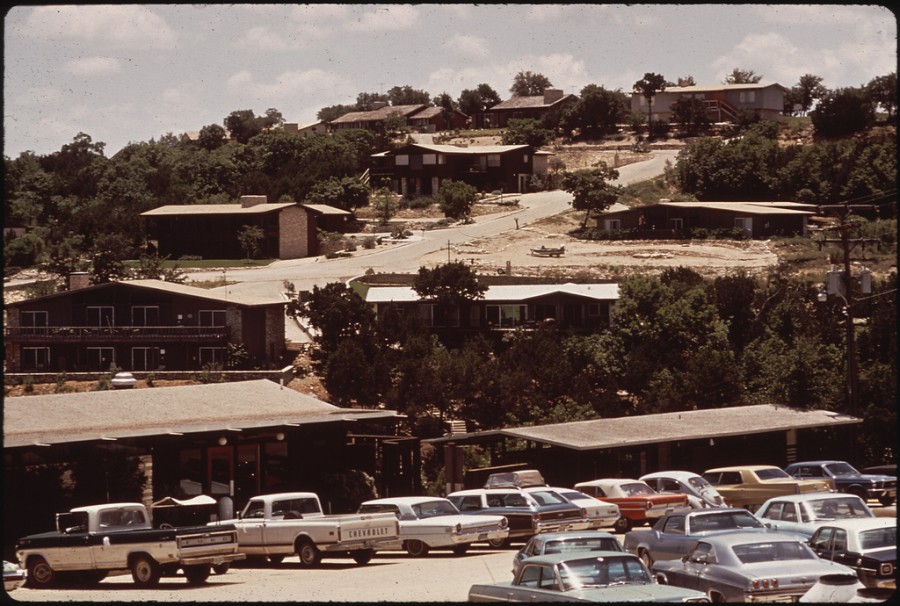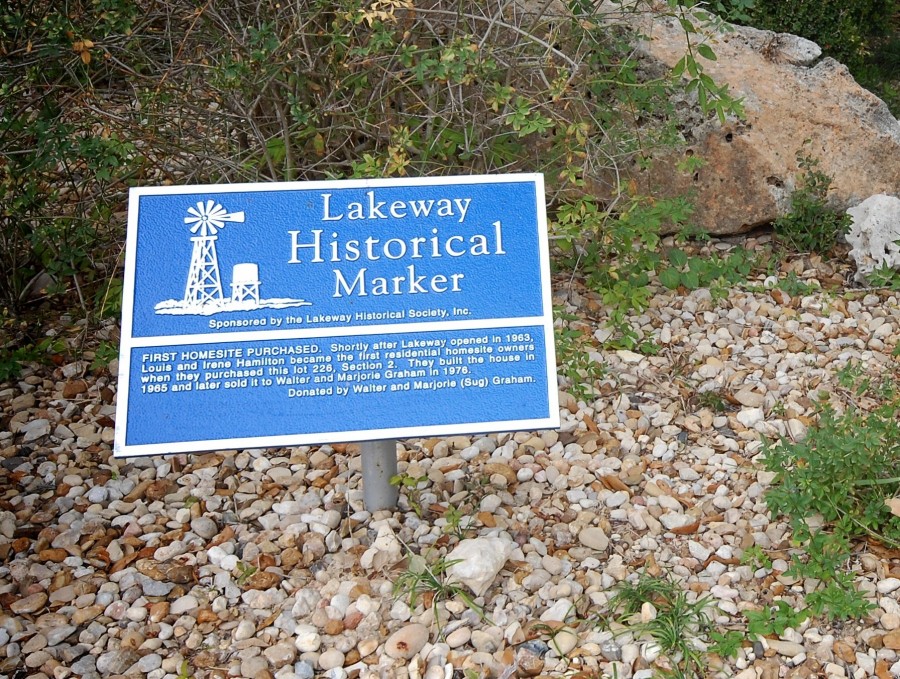At the outer edge of Austin’s city limits, 16 miles West of the city, sits the quaint community of Lakeway, Texas. What began as a relaxing resort town for vacationers and retirees, is now a growing city that has more than doubled in population since the 1990s. This exurb, although still relatively young, has a colorful and vibrant history consisting of many types of people settling in the Hill Country throughout the centuries.
The earliest settlers to the Texas Hill Country and Lakeway shared land with Native Americans, most notably the Tonkawa and later the Apache and Comanches. Looking around the lakeside community from its major road hub, Ranch Road 620, there are views of the surrounding hills and cedar fields so vast that you can almost imagine the first of the Tonkawa people to settle down in the area.
Making use of the natural flint found in the ground to make their tools and arrowheads, the indigenous people were also known for their pottery and copper jewelry. In time, more aggressive and warring tribes would push the natives out of their habitats and east of the Edwards Plateau.
Today, you can still find remnants of these early people in the Indian mounds that can be found scattered throughout Lakeway, including sites along both sides of Comet Street and in the front yard of 304 Lakeway Drive. You’ll want to be careful as you drive the neighborhood streets, as the area is still plentiful with wildlife and a booming deer population—which were the main sources of food for the tribes.
The Time Before Lake Travis
Although it is difficult to envision the area without Lake Travis, just one hundred years ago the landscape was very different in Lakeway. The two closest towns at the time were nearby Bee Cave to the South, and Teck to the North. Around the mid-1800s, many immigrants would move to the area and make the land more habitable, planting crops like beans and cotton, and raising their own livestock for food and essentials.
The earliest Anglo-American settlers to the Hill Country and Colorado River area were parts of several waves of German immigrants. From 1820-1860, over 600,000 Anglo-Americans migrated to Texas. In fact, by 1860 there were more German-born residents living in San Antonio than American born. This German heritage would permeate the local Texas culture of the area, as many Germans went on to establish such towns as New Ulm, Weimar, Freisburg and later Fredericksburg and New Braunfels.
A notable German-born businessman, Johann Heinrich Lohmann, was an implant to Texas who set his sights on the fertile land of Austin to make his home, along with his wife and four small children at the time. They made way to the new land by boat and landed in Galveston in 1842.
Traveling by wagon they finally made their way to an area in Austin that Lohmann named Ridgetop, what would later be known as the future site of the University of Texas at Austin.
Austin is where he would build and establish the first dairy in Travis County. In 1845, his 11 cows supplied milk to most of the Austin community, about 35 private homes and just the very early beginnings of the Capitol building.
Years later he would go on to build and maintain the road used for river crossing, Lohmanns Ford Road. As the years passed, the spelling was altered to drop one ‘n’ and today is known as Lohmans Crossing Road, which now runs through the center of Lakeway. These early roads and passages would be vital for pioneering families to use to traverse and travel into town and up to Anderson Mill, where they could grind their corn.
The first settlers had to be hardy in those days, many making their livelihoods as cedar choppers in the Hill Country. The area trees proved perfect for cutting down and making into coal to sell to the townspeople, making for a very lucrative business for those willing to get their hands dirty. It’s estimated that over 5 million acres of Cedar trees were cleared in Texas between 1900-1940 alone.
Another important family that settled in the area was the Hudson Family. In 1854 Wiley Hudson moved with his family to the land near the Colorado River bend, Hudson Bend. The family owned 4 of the original 25 tracts of land on the bend.
The Hudson family made their living as farmer-ranchers, living off the land and developing it to raise livestock and plants such as corn. Eventually as the Mansfield Dam was built and Lake Travis was created, about half of the Hudsons’ land was flooded. Today, Hudson Bend is home to many businesses and residents of the Lake Travis area.
The Dam That Changed Everything
It’s difficult to imagine life in Lakeway before Mansfield Dam was built, and the subsequent creation of Lake Travis, but this was one of the driving forces to the economic development in the area and Lakeway.
Before, flash floods would strike Central Texas causing mass flooding in the Hill Country all the way east to downtown Austin. Several storms struck Central Texas after the turn of the 20th century and devastated both lives and property.
By the 1930s, several U.S. Representatives were already in the process of securing the rights and the capital to build a dam in Austin that would go on to create Lake Travis. Representatives Lyndon Baines Johnson and J.J. Mansfield were men instrumental to the building of Mansfield Dam and helped to secure the area’s first hydro-electric power.
Excavation for Mansfield Dam started in 1937, and by January 27, 1941 the dam was already producing power to offer to area residents. This was one of the major seminal projects that would happen in the Lake Travis area to spur such economic developments to move West and conduct business on the new lake.
Lakeway Inn and the Town the Resort Created
It was a warm, sunny summer day in Austin, Texas, 1962. Three Houston businessmen descended on a newly-discovered inlet on Lake Travis, West of the city of Austin, taking with them plans and big dreams to build a hotel and spa right on the lake. Lake Travis was still largely underdeveloped at the time, and most land was owned by cattle ranchers and oil men. The original site of Lakeway Inn was on a 2,700-acre ranch owned by Houston oil man and rancher, Jack (Jake) Josey.
Saavy businessmen Flint Sawtelle, John H. Crooker and Lee Blocker, representing Gulfmont Hotel Company, obtained a 60-day option to buy land in the area and build the Lakeway Inn. The name “Lakeway” was chosen after Gulfmont’s Fairway Motor Hotel in McAllen, Texas, which overlooked a lush golf course below.
As time went on, the business partnership eventually expanded to include 10 people, who went on to purchase an additional 880 acres known as “Josie 1” to build their Inn and residential community. In 1964, another 2,817 acres were added to the original lot, and by May 30, 1963 property sales had already begun.
The official Grand Opening of the Lakeway Inn and Marina was in July of 1963, and many famous people would go on to become guests of the resort and hotel, including President LBJ and Lady Bird Johnson.
Lakeway as a community, however, still had a long way to go until it would be recognizable as the place it is today. By 1971 only 300 homes on 1,000 acres had been sold in the town. In July of 1974, a large majority of property owners voted to incorporate, with consent from the city of Austin, officially putting Lakeway on the map.
Lakeway Recreation
Many residents would name golf as one of the finest amenities to be experienced in Lakeway, as many of Texas’ premier golf courses can be found in the area, including The Hills, Flintrock Falls, Live Oak and Yaupon Golf Courses.
The World of Tennis Sports Complex at The Hills Country Club is another world-class fitness facility that is located in the community. Many tennis pros have practiced and played here, including Jimmy Connors and Peter Sampras.
Lakeway City Park is also a great stop for families and fitness-minded individuals. The 64-acre park site has a multitude of walking trails, beautifully maintained greenery and plant life, and exercise equipment. Don’t forget to bring your four legged friend to visit the dog park at City Park as well.
The Future of Lakeway
Imagine Lakeway and the Lake Travis area 50 years ago. Many homes and neighborhoods were a distant dream and many residents had never even heard of such a place. Now over 12,000 people call Lakeway home, and it’s just growing from here. Neighborhoods and master-planned communities such as The Hills of Lakeway and The Preserve at Lakeway are continuing to add new homes and experience growth.
As the city of Austin grows (110 people move to Austin on an average day), so does the Lake Travis area, bringing with the growth more businesses, recreational activities, restaurants and residents. The plans to add a traditional downtown are coming together as the City of Lakeway will be breaking ground on the Lakeway Town Center in 2014.
More about Lakeway:
- The original Lakeway Inn underwent a name change and is now known as Lakeway Resort and Spa.
- Lakeway is considered an exurb of Greater Austin.
- Lakeway is in the Lake Travis Independent School District.
- The community has over 100 acres of parks and trails.
Check out the Lake Travis Real Estate section for more information on historic landmarks, area neighborhoods, buying and selling tips, and local market conditions.
Bibliography:
Moore, R.E. “Tonkawa Indians, Texas Indians.” Tonkawa Indians, Texas Indians. N.p., n.d. Web. 05 Mar. 2014.
“Lakeway History.” City of Lakeway, TX. N.p., n.d. Web. 05 Mar. 2014.
Varner, Byron D. “Lakeway History.” City of Lakeway, TX. The City of Lakeway, n.d. Web. 06 Mar. 2014.
Carlson, Lewis H. Lakeway: A Hill Country Community. Helena: Sweetgrass, 2011. Print.
Post image via Creative Commons, The U.S. National Archives’ photostream on Flickr


Todd,
I just wanted to say how much I enjoyed reading this article about the LakeTravis History.
I have lived here for nearly 25 years and while reading your article I really felt like I reconnected with the area. I feel like this area has some really unique folks along with its surroundings.
Keep on the good work!
Sincerely,
Gil Vences
Thanks Gil!
Lakeway is a special and unique place for sure. A lot has changed over the past 25 years … I’m sure you’ve seen it all 🙂
In 1952 my brother was a senior at the University of Texas and my family visited the Austin area. My brother suggested we make the long winding road trip out to see Mansfield Dam and Lake Travis. As we traveled the narrow road from Austin westward we came upon fewer and fewer homes. One of our party said, “I don’t know why anyone would live this far from the city of Austin in these remote hills.” As a nine-year-old I had no idea that some 47 years later I would settle in Lakeway, which my family would call home and that we would see the area grow into the very attractive and dynamic town which is outstanding among communities in Travis County. I am proud to have called Lakeway “home” for the past twenty years. I appreciate the history of our growing city and area. It is a colorful and interesting story of progress.
Growing up and born in Austin, my mom and dad would gather us up and drive to Lakeway. Several years later, my mom bought 3 lots there and sold them some years later. Wish we would have kept at least 1 property. I would have retired there. Such a beautiful area!